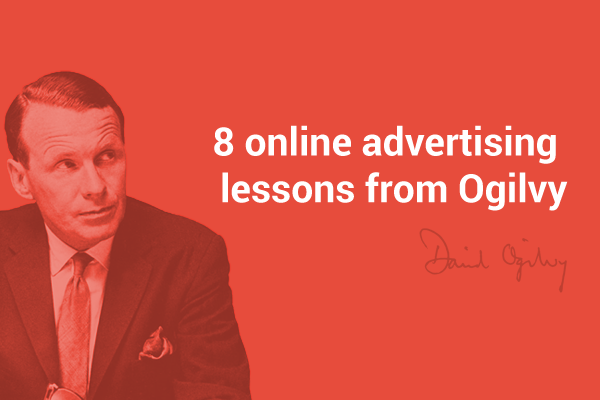“At 60 miles an hour, the loudest noise in this new Rolls-Royce comes from the electric clock.” The classic Rolls Royce ad was crafted by none other than David Ogilvy, also knows as “the Father of Advertising.”
David Ogilvy shaped the advertising world and inspired a lot of people to start a career in advertising. His research-grounded researched helped him craft simple, creative ads that both stuck and delivered results.
Even if advertising has evolved from mostly print and advertorials to static and interactive banner ads, some of David Ogilvy’s timeless insights apply to online advertising.
1. “Advertising people who ignore research are as dangerous as generals who ignore decodes of enemy signals.”
Before he started in advertising, Ogilvy worked as a researcher at the Gallup organization, and this strongly influenced his thinking and his approach.
Not only did he apply human behavior insights in his approach (more on that below), but Ogilvy also believed that successful advertising is based on information about the targeted audience. He would usually start work on his advertising campaigns by researching the product, audience, and competitors as much as possible. This allowed him to come up with unique, creative, and original ads.
Takeaway: Do your homework. The more information you have about the market (who are your customers, what are they interested in) and available technologies (retargeting, different platforms), the higher your chances of coming up with an innovative approach that gets the right kind of attention from your customers. Skip research, and you might come across as a copy or altogether irrelevant.
Ignore this piece of advice at your own expense.
2. “The consumer isn’t a moron. She is your wife.”
Advertising didn’t always treat the customer respectfully. Occasionally, it would be deceiving or address the customer from a superior position.
Ogilvy believed in treating the customer with respect and assuming that they’re just as smart as everyone, even if they’re not as well informed or as well educated.
Times have changed, and information today is just one Google search away. Moreover, it is known that 60% do extensive research before making a purchasing decision.
Takeaway: Don’t underestimate your audience or assume they are dumb. They’ll figure it out in no time.
3. “Never write an advertisement which you wouldn’t want your family to read. You wouldn’t tell lies to your own wife. Don’t tell them to mine.”
If respect is the first rule of thumb, being honest is the second.
People don’t want to be lied to. We might not always want to hear the truth, but we don’t want to be deliberately lied to. And you wouldn’t want someone telling you lies either.
Takeaway: Be honest with the ads that you create. Honesty inspires trust and long-term relationships.
4. “Consumers still buy products whose advertising promises them value for the money, beauty, nutrition, relief from suffering, social status, and so on.”
People are highly motivated by self-interest, by what’s in it for them. They like rewards, both physical and in status. We all want to be (or at least be perceived as) more intelligent, more beautiful, more healthy, or richer, and we’re going to try anything that helps us get closer to that.
Takeaway: If your product gives customers an advantage in any way or promises status, mention it. Highlight customer benefits as much as possible in your banner ads.
5. “On average, helpful information is read by 75 percent more people than copy which deals only with the product. This ad told how Rinso gets out stains. It was read and remembered.”
This might be biased as you don’t always have that much space in a banner ad. However, your landing page can complement the story you begin in your banner ad. Ogilvy stresses an important point here.
Takeaway: Offer your audience relevant, helpful information, and the chances of their remembering you grow considerably. Also, if available, use demos or evidence to support your product’s performance.
6. “I don’t know the rules of grammar. If you’re trying to persuade people to do something or buy something, it seems to me you should use their language.”
If you want people to listen, you need to speak their language. Language helps you establish a connection and convey your message. If your audience doesn’t understand what you’re saying, chances are that they won’t purchase or engage with your ad either.
Takeaway: Unless you’re advertising to a specific niche, use simple, plain, straightforward words and messages that are easy to understand. Talk in a way that is familiar and to which they can easily relate.
7. “If it doesn’t sell, it isn’t creative.”
Because you need creative input and skills to create an advertising campaign, the saying “creativity sells” emerged at one point. And we’ve seen it also: artistic shots, detailed photographs, movie-like TV ads.
But, the truth is you’re not advertising just for the sake of advertising or because you want to be seen as creative. You’re advertising because you want more customers or because you want to increase sales. Creativity (tactics you employ, messages, and imaging) should help you achieve your advertising goals, and that’s what Ogilvy is right to highlight.
Takeaway: Don’t try to be creative just to be creative. Set goals and make sure you’re using creativity to achieve your goals.
8. “Never stop testing, and your advertising will never stop improving.”
If you need more proof (or a sign in any kind of way) to start A/B testing, this is it. If The Father of advertising relied heavily on A/B testing, there’s no excuse for not running A/B tests and for not improving your clickthrough or your conversion rate. What’s more, digital advertising provides tools to run tests and get answers faster.
Takeaway: Always be testing :)
This is it – 8 timeless lessons from the father of advertising that you can apply today.
P.S.: Just wondering. What would Ogilvy say about retargeting?




Wayne
March 11, 2015Nice collection. Nice presentation. Double nice!